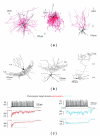Assortment of GABAergic plasticity in the cortical interneuron melting pot
- PMID: 21785736
- PMCID: PMC3139185
- DOI: 10.1155/2011/976856
Assortment of GABAergic plasticity in the cortical interneuron melting pot
Abstract
Cortical structures of the adult mammalian brain are characterized by a spectacular diversity of inhibitory interneurons, which use GABA as neurotransmitter. GABAergic neurotransmission is fundamental for integrating and filtering incoming information and dictating postsynaptic neuronal spike timing, therefore providing a tight temporal code used by each neuron, or ensemble of neurons, to perform sophisticated computational operations. However, the heterogeneity of cortical GABAergic cells is associated to equally diverse properties governing intrinsic excitability as well as strength, dynamic range, spatial extent, anatomical localization, and molecular components of inhibitory synaptic connections that they form with pyramidal neurons. Recent studies showed that similarly to their excitatory (glutamatergic) counterparts, also inhibitory synapses can undergo activity-dependent changes in their strength. Here, some aspects related to plasticity and modulation of adult cortical and hippocampal GABAergic synaptic transmission will be reviewed, aiming at providing a fresh perspective towards the elucidation of the role played by specific cellular elements of cortical microcircuits during both physiological and pathological operations.
Figures




Similar articles
-
Shaping inhibition: activity dependent structural plasticity of GABAergic synapses.Front Cell Neurosci. 2014 Oct 27;8:327. doi: 10.3389/fncel.2014.00327. eCollection 2014. Front Cell Neurosci. 2014. PMID: 25386117 Free PMC article. Review.
-
Postsynaptic effects of GABAergic synaptic diversity: regulation of neuronal excitability by changes in IPSC variance.Neuropharmacology. 2002 Sep;43(4):511-22. doi: 10.1016/s0028-3908(02)00167-3. Neuropharmacology. 2002. PMID: 12367598
-
Properties and dynamics of inhibitory synaptic communication within the CA3 microcircuits of pyramidal cells and interneurons expressing parvalbumin or cholecystokinin.J Physiol. 2016 Jul 1;594(13):3745-74. doi: 10.1113/JP272231. Epub 2016 May 5. J Physiol. 2016. PMID: 27038232 Free PMC article.
-
Synchronization of neuronal activity in hippocampus by individual GABAergic interneurons.Nature. 1995 Nov 2;378(6552):75-8. doi: 10.1038/378075a0. Nature. 1995. PMID: 7477292
-
LTP and LTD in cortical GABAergic interneurons: emerging rules and roles.Neuropharmacology. 2011 Apr;60(5):712-9. doi: 10.1016/j.neuropharm.2010.12.020. Epub 2010 Dec 23. Neuropharmacology. 2011. PMID: 21185319 Review.
Cited by
-
Shaping inhibition: activity dependent structural plasticity of GABAergic synapses.Front Cell Neurosci. 2014 Oct 27;8:327. doi: 10.3389/fncel.2014.00327. eCollection 2014. Front Cell Neurosci. 2014. PMID: 25386117 Free PMC article. Review.
-
Sensitive periods in fear learning and memory.Stress. 2014 Jan;17(1):13-21. doi: 10.3109/10253890.2013.796355. Epub 2013 May 28. Stress. 2014. PMID: 23611461 Free PMC article. Review.
-
Spatio-temporal mapping cortical neuroplasticity in carpal tunnel syndrome.Brain. 2012 Oct;135(Pt 10):3062-73. doi: 10.1093/brain/aws233. Epub 2012 Oct 4. Brain. 2012. PMID: 23043143 Free PMC article.
-
Protein Kinase A-Dependent Plasticity of Local Inhibitory Synapses from Hilar Somatostatin-Expressing Neurons.eNeuro. 2023 Oct 6;10(10):ENEURO.0089-23.2023. doi: 10.1523/ENEURO.0089-23.2023. Print 2023 Oct. eNeuro. 2023. PMID: 37734950 Free PMC article.
-
Molecular Mechanisms of Epilepsy: The Role of the Chloride Transporter KCC2.J Mol Neurosci. 2022 Jul;72(7):1500-1515. doi: 10.1007/s12031-022-02041-7. Epub 2022 Jul 12. J Mol Neurosci. 2022. PMID: 35819636 Review.
References
-
- Buzsáki G, Draguhn A. Neuronal olscillations in cortical networks. Science. 2004;304(5679):1926–1929. - PubMed
Publication types
MeSH terms
Substances
Grants and funding
LinkOut - more resources
Full Text Sources

